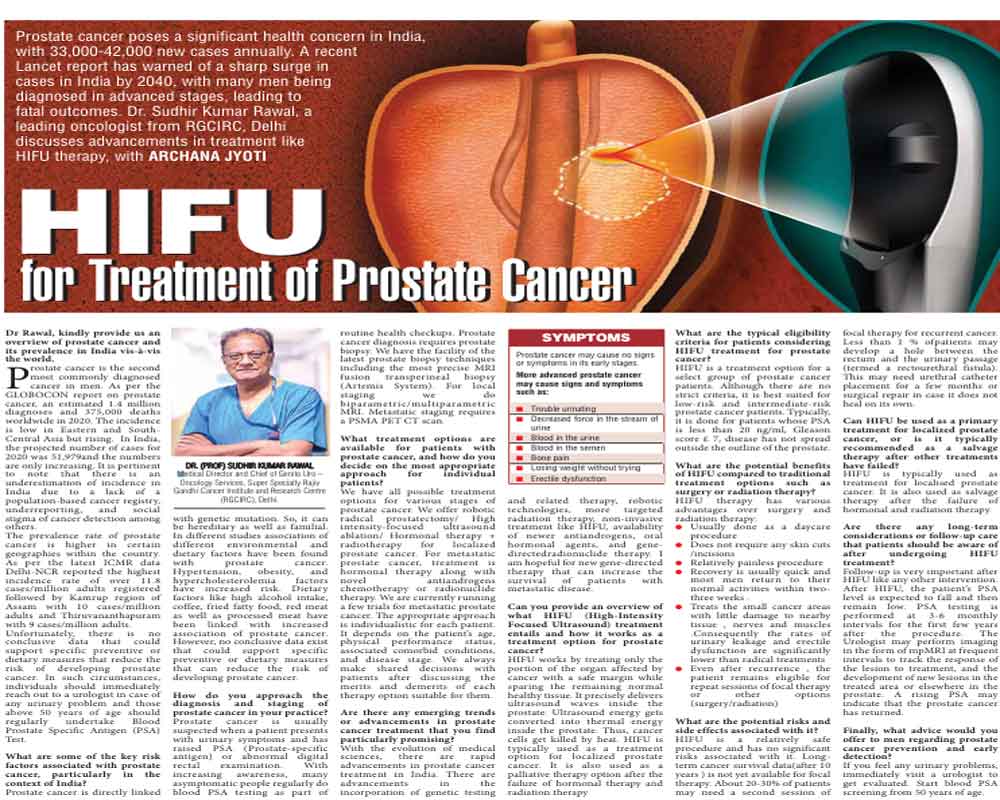Prostate cancer poses a significant health concern in India, with 33,000-42,000 new cases annually. A recent Lancet report has warned of a sharp surge in cases in India by 2040, with many men being diagnosed in advanced stages, leading to fatal outcomes. Dr. Sudhir Kumar Rawal, a leading oncologist from RGCIRC, Delhi discusses advancements in treatment like HIFU therapy, with ARCHANA JYOTI
Dr Rawal, kindly provide us an overview of prostate cancer and its prevalence in India vis-à-vis the world.
Prostate cancer is the second most commonly diagnosed cancer in men. As per the GLOBOCON report on prostate cancer, an estimated 1.4 million diagnoses and 375,000 deaths worldwide in 2020. The incidence is low in Eastern and South-Central Asia but rising. In India, the projected number of cases for 2020 was 51,979and the numbers are only increasing. It is pertinent to note that there is an underestimation of incidence in India due to a lack of a population-based cancer registry, underreporting, and social stigma of cancer detection among others.
The prevalence rate of prostate cancer is higher in certain geographies within the country. As per the latest ICMR data Delhi-NCR reported the highest incidence rate of over 11.8 cases/million adults registered followed by Kamrup region of Assam with 10 cases/million adults and Thiruvananthapuram with 9 cases/million adults.
Unfortunately, there is no conclusive data that could support specific preventive or dietary measures that reduce the risk of developing prostate cancer. In such circumstances, individuals should immediately reach out to a urologist in case of any urinary problem and those above 50 years of age should regularly undertake Blood Prostate Specific Antigen (PSA) Test.
What are some of the key risk factors associated with prostate cancer, particularly in the context of India?
Prostate cancer is directly linked with genetic mutation. So, it can be hereditary as well as familial. In different studies association of different environmental and dietary factors have been found with prostate cancer. Hypertension, obesity, and hypercholesterolemia factors have increased risk. Dietary factors like high alcohol intake, coffee, fried fatty food, red meat as well as processed meat have been linked with increased association of prostate cancer. However, no conclusive data exist that could support specific preventive or dietary measures that can reduce the risk of developing prostate cancer.
How do you approach the diagnosis and staging of prostate cancer in your practice?
Prostate cancer is usually suspected when a patient presents with urinary symptoms and has raised PSA (Prostate-specific antigen) or abnormal digital rectal examination. With increasing awareness, many asymptomatic people regularly do blood PSA testing as part of routine health checkups. Prostate cancer diagnosis requires prostate biopsy. We have the facility of the latest prostate biopsy techniques including the most precise MRI fusion transperineal biopsy (Artemis System). For local staging we do biparametric/multiparametric MRI. Metastatic staging requires a PSMA PET CT scan.
What treatment options are available for patients with prostate cancer, and how do you decide on the most appropriate approach for individual patients?
We have all possible treatment options for various stages of prostate cancer. We offer robotic radical prostatectomy/ High intensity-focused ultrasound ablation/ Hormonal therapy + radiotherapy for localized prostate cancer. For metastatic prostate cancer, treatment is hormonal therapy along with novel antiandrogens chemotherapy or radionuclide therapy. We are currently running a few trials for metastatic prostate cancer. The appropriate approach is individualistic for each patient. It depends on the patient’s age, physical performance status, associated comorbid conditions, and disease stage. We always make shared decisions with patients after discussing the merits and demerits of each therapy option suitable for them.
Are there any emerging trends or advancements in prostate cancer treatment that you find particularly promising?
With the evolution of medical sciences, there are rapid advancements in prostate cancer treatment in India. There are advancements in the incorporation of genetic testing and related therapy, robotic technologies, more targeted radiation therapy, non-invasive treatment like HIFU, availability of newer antiandrogens, oral hormonal agents, and gene-directedradionuclide therapy. I am hopeful for new gene-directed therapy that can increase the survival of patients with metastatic disease.
Can you provide an overview of what HIFU (High-Intensity Focused Ultrasound) treatment entails and how it works as a treatment option for prostate cancer?
HIFU works by treating only the portion of the organ affected by cancer with a safe margin while sparing the remaining normal healthy tissue. It precisely delivers ultrasound waves inside the prostate. Ultrasound energy gets converted into thermal energy inside the prostate. Thus, cancer cells get killed by heat. HIFU is typically used as a treatment option for localized prostate cancer. It is also used as a palliative therapy option after the failure of hormonal therapy and radiation therapy
What are the typical eligibility criteria for patients considering HIFU treatment for prostate cancer?
HIFU is a treatment option for a select group of prostate cancer patients. Although there are no strict criteria, it is best suited for low-risk and intermediate-risk prostate cancer patients. Typically, it is done for patients whose PSA is less than 20 ng/ml, Gleason score £ 7, disease has not spread outside the outline of the prostate.
What are the potential benefits of HIFU compared to traditional treatment options such as surgery or radiation therapy?
HIFU therapy has various advantages over surgery and radiation therapy:
- Usually done as a daycare procedure
- Does not require any skin cuts /incisions
- Relatively painless procedure
- Recovery is usually quick and most men return to their normal activities within two-three weeks .
- Treats the small cancer areas with little damage to nearby tissue , nerves and muscles .Consequently the rates of urinary leakage and erectile dysfunction are significantly lower than radical treatments
- Even after recurrence , the patient remains eligible for repeat sessions of focal therapy or other options (surgery/radiation)
What are the potential risks and side effects associated with it?
HIFU is a relatively safe procedure and has no significant risks associated with it. Long-term cancer survival data(after 10 years ) is not yet available for focal therapy. About 20-30% of patients may need a second session of focal therapy for recurrent cancer. Less than 1 % ofpatients may develop a hole between the rectum and the urinary passage (termed a rectourethral fistula). This may need urethral catheter placement for a few months or surgical repair in case it does not heal on its own.
Can HIFU be used as a primary treatment for localized prostate cancer, or is it typically recommended as a salvage therapy after other treatments have failed?
HIFU is typically used as treatment for localised prostate cancer. It is also used as salvage therapy after the failure of hormonal and radiation therapy.
Are there any long-term considerations or follow-up care that patients should be aware of after undergoing HIFU treatment?
Follow-up is very important after HIFU like any other intervention. After HIFU, the patient’s PSA level is expected to fall and then remain low. PSA testing is performed at 3-6 monthly intervals for the first few years after the procedure. The Urologist may perform imaging in the form of mpMRI at frequent intervals to track the response of the lesion to treatment, and the development of new lesions in the treated area or elsewhere in the prostate. A rising PSA may indicate that the prostate cancer has returned.
Finally, what advice would you offer to men regarding prostate cancer prevention and early detection?
If you feel any urinary problems, immediately visit a urologist to get evaluated. Start blood PSA screening from 50 years of age.


























